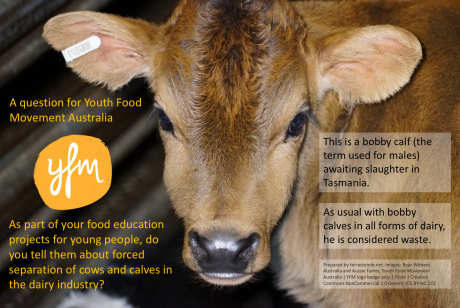I have written three articles dealing with Youth Food Movement Australia (YFM) and its relationships with the animal agriculture sector. Links to the articles can be found below this post, which outlines some questions for the organisation in the form of memes.
Some of the memes refer to “BeefJam”, which was a project in which YFM collaborated with “Target 100”, an initiative of: Meat & Livestock Australia; Australian Lot Feeders Association; Sheep Meat Council of Australia; Cattle Council of Australia; and Australian Meat Industry Council.
YFM has described BeefJam as “a 3-day event that takes young producers and consumers on a crash course of the Australian beef supply chain and gives them 48hrs to reshape the way we grow, buy and eat our red meat.”
I’ve seen some very slick videos released jointly by Target 100 and YFM about the event that look to me like promotions for the meat industry. However, I have seen no evidence of the fifteen “young consumers” and “young producers” who attended reshaping the industry.
The links between YFM and the livestock sector also include the fact that co-founder, Joanna Baker, spent nearly two years (while also holding senior positions with YFM) as manager for membership, communications and policy at Dairy Connect. That organisation describes itself as “an advocacy body, 100% focused on being the voice for all partners in the dairy industry”.
The other YFM co-founder, Alexandra Iljadica, was a speaker at the two-day 2016 Australian Dairy Conference, sharing speaking duties with high-profile industry participants. She was given two speaking opportunities; a plenary speech and a workshop, with the title of the latter being, “How to herd consumers toward Australian dairy: A workshop in human behaviour change”.
I believe it is important for YFM to keep in mind its professed values of transparency and authenticity and its stated role of running “food education projects for young people”.
Here are the memes. I hope they cause those involved with YFM to consider issues involved in food consumption beyond those that the organisation appears to have addressed to date.
Conclusion
I believe any group that states its mission is to “grow a generation of young Australians empowered with the ability to make healthy and sustainable food choices” must highlight the issues raised in this post.
I look forward to seeing if YFM addresses the issues in future.
Author
References
Animals Australia, “What you never knew about dairy”, http://www.animalsaustralia.org/issues/dairy.php
Australian Animal Welfare Standards and Guidelines for Cattle, http://www.animalwelfarestandards.net.au/cattle/
Kroon, F., Turner, R., Smith, R., Warne, M., Hunter, H., Bartley, R., Wilkinson, S., Lewis, S., Waters, D., Caroll, C., 2013 “Scientific Consensus Statement: Sources of sediment, nutrients, pesticides and other pollutants in the Great Barrier Reef Catchment”, Ch. 4, p. 12, The State of Queensland, Reef Water Quality Protection Plan Secretariat, July, 2013, http://www.reefplan.qld.gov.au/about/scientific-consensus-statement/sources-of-pollutants.aspx
Brodie, J., “Great Barrier Reef dying beneath its crown of thorns”, The Conversation, 16th April, 2012, http://theconversation.com/great-barrier-reef-dying-beneath-its-crown-of-thorns-6383
Queensland Department of Science, Information Technology and Innovation, 2016. Land cover change in Queensland 2015–16: Statewide Landcover and Trees Study report. DSITI, Brisbane
World Wide Fund for Nature, “Accelerating bushland destruction in Queensland: Clearing under Self Assessable Codes takes major leap upward”, March 2017, http://www.wwf.org.au/ArticleDocuments/360/pub-accelerating-bushland-destruction-in-queensland-21mar17.pdf.aspx?Embed=Yx
Harper, L.A., Denmead, O.T., Freney, J.R., and Byers, F.M., Journal of Animal Science, June, 1999, “Direct measurements of methane emissions from grazing and feedlot cattle”, J ANIM SCI, 1999, 77:1392-1401, http://www.ncbi.nlm.nih.gov/pubmed/10375217; http://www.journalofanimalscience.org/content/77/6/1392.full.pdf
Eshel, G., “Grass-fed beef packs a punch to environment”, Reuters Environment Forum, 8 Apr 2010, http://blogs.reuters.com/environment/2010/04/08/grass-fed-beef-packs-a-punch-to-environment/
Wedderburn-Bisshop, G., Longmire, A., Rickards, L., “Neglected Transformational Responses: Implications of Excluding Short Lived Emissions and Near Term Projections in Greenhouse Gas Accounting”, International Journal of Climate Change: Impacts and Responses, Volume 7, Issue 3, September 2015, pp.11-27. Article: Print (Spiral Bound). Published Online: August 17, 2015, http://ijc.cgpublisher.com/product/pub.185/prod.269
Springmann, M., Godfray, H.C.J., Rayner, M., Scarborough, P., “Analysis and valuation of the health and climate change cobenefits of dietary change”, PNAS 2016 113 (15) 4146-4151; published ahead of print March 21, 2016, doi:10.1073/pnas.1523119113, (print edition 12 Apr 2016), http://www.pnas.org/content/113/15/4146.full and http://www.pnas.org/content/113/15/4146.full.pdf
Images
Bear Witness Australia and Aussie Farms | 5-day old bobby calves from the dairy industry | The Aussie Farms Repository | https://www.aussiefarms.org.au/photos/food/dairy
Branding a calf | anrodphoto | iStock
Brian Kinney | Wonderful and beautiful underwater world with corals and tropical fish | Shutterstock
The Wilderness Society | Land clearing: Olive Vale, Queensland, 2014 (Youtube video) | https://www.youtube.com/watch?v=Uc06o7ayx-g
Sherjarca | Australian beef cattle charolais bred for meat | Shutterstock
Nyul | Medical team in operating room | Dreamstime.com
Youth Food Movement Australia | YFM logo badge only | Flickr | Creative Commons NonCommercial 2.0 Generic (CC BY-NC 2.0)







